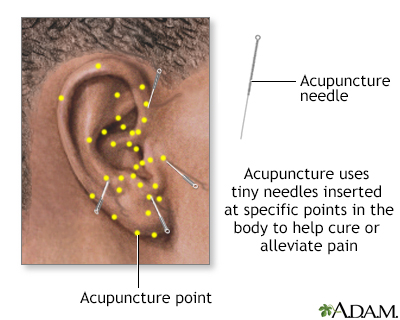Alternative medicine - pain relief
Alternative medicine for pain relief refers to treatments that are used instead of conventional (standard) ones. Typically, they are low- or no-risk treatments. If you use an alternative treatment along with conventional medicine or therapy, it is considered complementary therapy.
Information
There are many forms of alternative medicine for pain relief. They include acupuncture, chiropractic, herbal medicine, massage, magnetic waves, hypnosis, biofeedback, meditation, yoga, and tai-chi.
Acupuncture involves stimulating certain acupoints on the body using fine needles or other methods. How acupuncture works is not entirely clear. It is thought that acupoints lie near nerve fibers. When acupoints are stimulated, the nerve fibers signal the spinal cord and brain to release chemicals that relieve pain.
Acupuncture is an effective means of relieving pain, such as for back pain and headache pain. Acupuncture may also help relieve pain due to:
Headache
A headache is pain or discomfort in the head, scalp, or neck. Serious causes of headaches are rare. Most people with headaches can feel much better...

- Cancer
-
Carpal tunnel syndrome
Carpal tunnel syndrome
Carpal tunnel syndrome is a condition in which there is excessive pressure on the median nerve at the wrist. This is the nerve that allows feeling a...
 ImageRead Article Now Book Mark Article
ImageRead Article Now Book Mark Article -
Fibromyalgia
Fibromyalgia
Fibromyalgia is a condition in which a person has long-term pain that is spread throughout their body. The pain is most often accompanied by fatigue...
 ImageRead Article Now Book Mark Article
ImageRead Article Now Book Mark Article - Childbirth (labor)
- Musculoskeletal injuries (such as the neck, shoulder, knee, or elbow)
-
Osteoarthritis
Osteoarthritis
Osteoarthritis (OA) is the most common joint disorder. It is due to aging and wear and tear on a joint.
 ImageRead Article Now Book Mark Article
ImageRead Article Now Book Mark Article -
Rheumatoid arthritis
Rheumatoid arthritis
Rheumatoid arthritis (RA) is a disease that leads to inflammation of the joints and surrounding tissues. It is a long-term disease. It can also aff...
 ImageRead Article Now Book Mark Article
ImageRead Article Now Book Mark Article
Hypnosis is a focused state of concentration. With self-hypnosis, you repeat a positive statement over and over.
Hypnosis may help relieve pain for:
- After surgery or labor
- Arthritis
- Cancer
- Fibromyalgia
-
Irritable bowel syndrome
Irritable bowel syndrome
Irritable bowel syndrome (IBS) is a disorder that leads to pain in abdomen and changes in bowel movements. IBS is not the same as inflammatory bowel...
 ImageRead Article Now Book Mark Article
ImageRead Article Now Book Mark Article -
Migraine headache
Migraine headache
A migraine is a type of headache. It may occur with symptoms such as nausea, vomiting, or sensitivity to light and sound. In most people, a throbbi...
 ImageRead Article Now Book Mark Article
ImageRead Article Now Book Mark Article -
Tension headache
Tension headache
A tension headache is the most common type of headache. It is pain or discomfort in the head, scalp, or neck, and is often associated with muscle ti...
 ImageRead Article Now Book Mark Article
ImageRead Article Now Book Mark Article
Both acupuncture and hypnosis are often offered by pain management centers in the United States. Other non-drug methods used at such centers include:
-
Biofeedback
Biofeedback
Biofeedback is a technique that measures bodily functions and gives you information about them in order to help train you to control them.
 ImageRead Article Now Book Mark Article
ImageRead Article Now Book Mark Article - Massage
- Relaxation training
- Physical therapy
Biofeedback provides information about your body such as blood pressure, muscle tension, and others. One can find how to take control of these functions to help their symptoms. Herbal medicine involves the use of various parts of plants. Many herbal medicines can interact with prescribed medicines, or can have other undesired effects. It is important to discuss all herbal therapies with your health care provider.
Some find magnetic waves helpful for healing, but these can interfere with certain medical devices and should be used only under direction of a medical provider during pregnancy.
Reviewed By
Joseph V. Campellone, MD, Department of Neurology, Cooper Medical School at Rowan University, Camden, NJ. Review provided by VeriMed Healthcare Network. Also reviewed by David C. Dugdale, MD, Medical Director, Brenda Conaway, Editorial Director, and the A.D.A.M. Editorial team.
Hecht FM. Complementary, alternative, and integrative medicine. In: Goldman L, Cooney KA, eds. Goldman-Cecil Medicine. 27th ed. Philadelphia, PA: Elsevier; 2024:chap 30.
Hsu ES, Wu I, Lai B. Acupuncture. In: Benzon HT, Raja SN, Liu SS, Fishman SM, Cohen SP, eds. Essentials of Pain Medicine. 4th ed. Philadelphia, PA: Elsevier; 2018:chap 60.
White JD. Complementary and alternative medicine. In: Niederhuber JE, Armitage JO, Kastan MB, Doroshow JH, Tepper JE, eds. Abeloff's Clinical Oncology. 6th ed. Philadelphia, PA: Elsevier; 2020:chap 31.
Disclaimer


 All rights reserved.
All rights reserved.